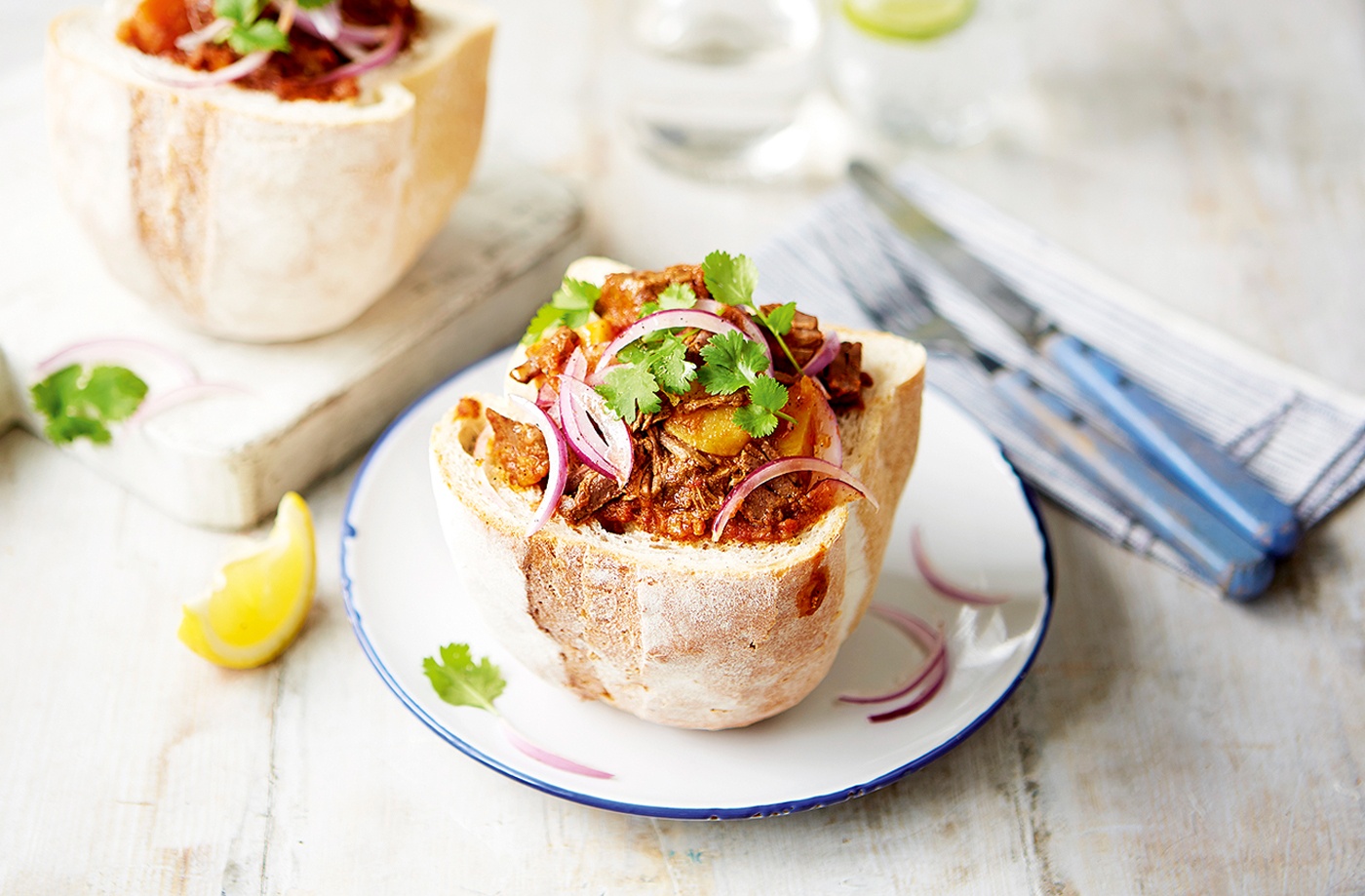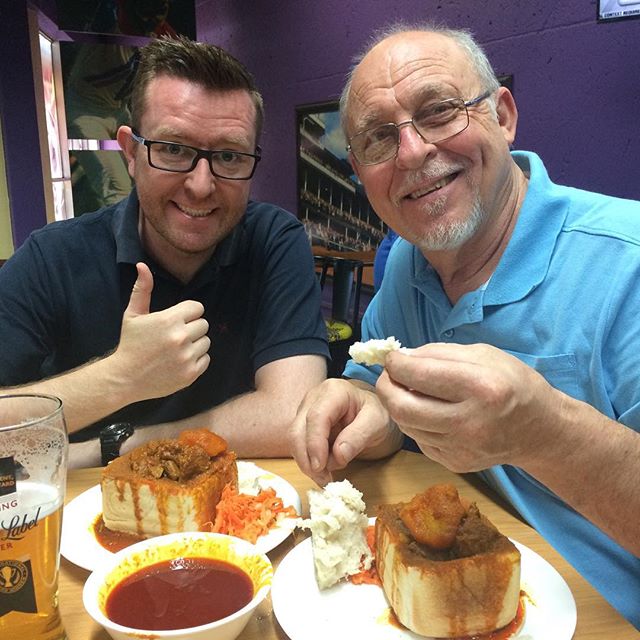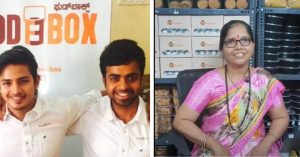The Story of Durban’s Bunny Chow, An Indian Dish Difficult to Find in India!
The intriguing origins of this delicious fusion dish can be traced to one of the largest Indian communities outside India.

Cheap, filling and deliciously rustic, bunny chow is one of the most popular takeaway meals in Durban, South Africa’s third-largest city. With a name like that, you’d think this much-loved street snack would have something to do with rabbits. It doesn’t.
Bunny chow is essentially a piping hot curry — housed inside a hollow loaf of bread — with intriguing origins that can be traced to one of the largest Indian communities outside India. Here’s the fascinating story of this unusual dish.

There are many stories about how bunny chow originated, but the most cited version often describes it as a no-fuss invented by Indian immigrants in Durban during the apartheid years (a discriminatory system of racial separation) between 1948 to 1994.
This was a time when Indians had started coming to South Africa in droves — first, as indentured servants to work in the sugar cane fields around Durban, and soon after, by “passenger Indians”(so-called because they paid their own way) who came to work as merchants or artisans.
According to one theory, the ‘bunny’ was created in the 1940s at Kapitan’s, a small restaurant in Durban that was popular among Indian immigrants for its delicious roti and bean curry combination.
Since apartheid laws forbade black people from entering eateries, their only option was take away. Faced by the challenge of containing the beans inside the roti (to create an easily portable meal), restaurant’s ingenious Indian owner, GC Kapitan, decided to serve the curry inside a hollowed-out quarter loaf of bread.

The sturdy bread loaf worked like an edible container that could transport curry to the sugarcane plantations to eat during the day. Other than sating the craving for a traditional meal by rather unconventional means, this idea also ensured that nothing needed to be returned after eating.
As Kapitan was a bania ( an Indian community of merchants and traders), the natives called his classic fusion creation ‘Bania’s Chow’, which soon metamorphosed into the colloquial bunny chow! Such was its popularity that the Kapitan restaurant had soon established its branches in other South African cities. In fact, a young Nelson Mandela was a regular at the eatery’s Johannesburg offshoot!
Interestingly, this story is disputed by Patel’s Vegetarian Refreshment Room on Durban’s Yusuf Dadoo (Grey) Street. Established nearly 90 years ago, the restaurant claims to be the home of the original veg bunny chow and says that it was created by its founder Rambhar Morar Patel to retain their black customers. The myriad non-veg versions of this dish came much later, after the dish gained massive popularity in the region.

Yet another theory goes that bunny chow was originally invented for Indian caddies at the Royal Durban Golf Course who, at lunchtime, were unable to run down to Grey street for their meal. Thus, either their family members or their friends would fill these portable bread bowls to the brim with curries and surreptitiously bring them back to the golf course for their lunch.
Today, the scrumptious curry-in-a-loaf is ubiquitous in Durban, where it is sold everywhere, from posh casinos to tiny takeaway kiosks. It also gaining global fame as a delicious example of cross-cultural fusion: an Indian style curry made with native South African spices and eaten with European-style bread.

As bunny chow is still rarely ever served with a knife or a fork, customers use the bread on top to scoop up the spicy gravy, tearing their way round the loaf until reaching the delectably curry-soaked bread remnants at the bottom. Interestingly, the most common side order with ‘bunnies’ are sambals, a flavourful salad-like medley of grated carrots, chili and onions
Over the years, bunny chow has become an intricate part of Durban’s culinary culture. In fact, such is its influence that a local radio station even featured the dish in a public service advertisement against domestic violence. In the ad, a couple argues about whether it’s ever ok to eat a bunny with a knife and fork. “No, not each one to his own!” the man insists, arguing that some things are just not acceptable, just like violence against women and children.
Furthermore, the city of Durban also hosts a competition every year in September, called the Bunny Chow Barometer, that attracts a multitude of competitors all vying for the title of the champion bunny maker!

So if you are in this South African city and would like to try some ‘bunny’, here’s the rule of thumb that the local foodies swear by — if you see a hole-in-the-wall joint with an Indian name, it probably serves spectacular curry!
However, if you are tempted to try this dish but don’t have any plans of visiting South Africa soon, fret not. Because dish has finally started making an appearance in India too. To try a helping, head to Lower Parel’s PDT (Please Don’t Tell) and Khar’s Me So Happi in Mumbai. In NCR, you can try this dish at Papa Buns in Delhi’s Satya Niketan, The Classroom in Gurgaon’s Sector 29 and Our Story in Noida’s Sector 18.
And for those of you who are tempted to make your own ‘bunny’, but don’t have access to a place serving it, here’s a recipe you can try at home. Bon appetit, folks!
You May Like: How an Indian Freedom Fighter’s Curry Became a Sensation in Japan
Like this story? Or have something to share? Write to us: [email protected], or connect with us on Facebook and Twitter.
NEW: Click here to get positive news on WhatsApp!
This story made me
- 97
- 121
- 89
- 167
Tell Us More
We bring stories straight from the heart of India, to inspire millions and create a wave of impact. Our positive movement is growing bigger everyday, and we would love for you to join it.
Please contribute whatever you can, every little penny helps our team in bringing you more stories that support dreams and spread hope.



















